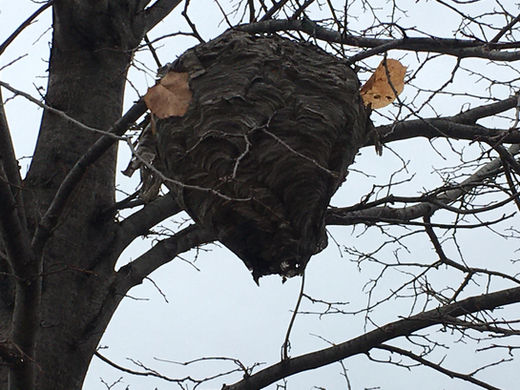Baldfaced Hornet
Common Name: Baldfaced Hornet.
Scientific Name: Dolichovespula Maculata.
What to look for? Blackish-blue and white, armored bee-like insect with a distinctive body! The Baldfaced Hornet is actually not a “hornet”, but is a yellow-jacket, which is really a wasp. Confusing? Yes! It gets its name from the ivory-white markings on the face. The Baldfaced Hornet has a stout body that is distinctive, having a extremely narrow "waist" that joins the abdomen to the thorax. The thorax, legs and abdomen also have white markings. Another conspicuous feature of the Baldfaced Hornet are its large antennae.
Where can they be found at Carillon Stonegate Pond? The Baldfaced Hornet is not a regular sighting – and that may be desired. I found one visiting our hosta plants.
How big are they? The female Baldfaced Hornet averages approximately three-fourths of one inch in length; a male Baldfaced Hornet is smaller, averaging just over one-half of one inch in length.
What are their flight patterns? Baldfaced Hornets are fast and agile in flight.
How else do they behave? The Baldfaced Hornet is an aggressive protector of its nest.
What’s for dinner? Insects - primarily! The Baldfaced Hornet diets on soft-bodied insects including caterpillars and aphids. They also harvest nectar for carbs and pollen for protein from flowering plants.
Where do they take up residence? The Baldfaced Hornet lives throughout North America. They are most common in the southeastern United States. Their habitat ranges from developed areas like backyards, parks and gardens, to forests and meadows, but always near a woodland area.
When and where do they breed and nest? Bald-faced Hornets are social insects that live in large colonies. A colony consists of a queen, several hundred winged infertile female workers, brood (eggs, larvae and pupae) and, by late summer, males and reproductive females. Each colony is a family with all descended from a single queen. Each member has specific tasks to help support the colony. Queens are the only members of the colony able to survive the winter. In April or May, the queen selects a suitable location, constructs a small nest and begins raising sterile daughter offspring. Bald-faced Hornets build their nests in trees and shrubs and construct them out of wood pulp – literally paper! The queen lays all of the eggs in a colony and fertilizes each egg as it is being laid. The queen occasionally will not fertilize an egg. These non-fertilized eggs develop into male drones. The primary function of a male drone is to be ready to fertilize the queen. Worker hornets take on the duties of enlarging and maintaining the nest, foraging for food and caring for the offspring, while the queen functions only to produce more eggs.
Where do they migrate? The Bald-faced Hornet does not migrate.
Do they make any interesting sounds? Not really, although they will vibrate their wings together resulting in a loud warning to intruders.
Interesting Facts About the Baldfaced Hornet:
-
Baldfaced Hornets can be considered a beneficial insect in that they reduce populations of unwanted insects.
-
The Baldfaced Hornet construct gray, football-shaped, paper nests that are usually found hanging in a tree or shrub. These nests die off during the winter.
-
The Baldfaced Hornet resides only in North America.
-
Wasps like the Baldfaced Hornet, bees and ants (the order "Hymenoptera") differ from other insects by having two pairs of wings that are linked by a row of hooks, and by having a narrow "waist" that joins the abdomen to the thorax.
For more information on the Bald-faced Hornet and sources of information used in this blog (these are the several of the sources that I am using to learn as I blog), please visit Nature Mapping Program, Iowa State University Bug Guide, Penn State University Entomology and University of Virginia Mountain Lake Biological Station.
The Carillon at Stonegate community is very fortunate to have a variety of wetland, forest and prairie environments conducive to a variety of birds and other wildlife, insects and plants. Our community and the Kane County Forest Preserve do an exceptional job in maintaining this natural environment – both for the benefit of the birds and wildlife and for our residents to enjoy.
Take a hike and see what you can find – and identify!





